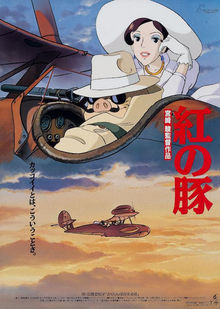We’re nearly done with the slate of Studio Ghibli films and here we come to an old one that my wife said she fell asleep watching back in the day. This is admittedly one of Hayao Miyazaki’s lightest and simplest films. It encapsulates nothing but Miyazaki’s love of aircraft and specifically the aircraft of the pre-World War 2 era. There is combat but it’s treated as comedic playacting with no one dying or even getting seriously hurt. This is barely more sophisticated than a children’s cartoon but I found I rather liked the purity of its vision. Miyayaki knew exactly what he wanted to express here and so he did it without caring about what anyone else thought.
Porco Rosso is a former Italian fighter ace of the First World War whose head has been transformed into that of a pig due to a curse. He now lives on his own island in the Adriatic Sea and makes money by being a bounty hunter flying his iconic red plane. One day he gets a call to intervene in the case of an ocean liner that is attacked by airborne pirates. He saves the little girls kidnapped by the pirates and retrieves half of the stolen money, leaving the other half for the pirates’ repairs. At night, he relaxes at the Hotel Adriano, owned by the torch singer Gina who all of the pilots are in love with. The pirates contract a rising American ace pilot Curtis to take Porco Rosso down. It so happens that Porco Rosso has been having trouble with his engine and is flying to Milan to get it fixed. Curtis comes across his ailing plane and easily shoots him down. Porco Rosso survives and continues his trip to Milan. There, his friend the mechanic Piccolo assigns his granddaughter Fio to supervise the reconstruction and upgrading of the place. Porco Rosso is skeptical at first and dubious about wasting his money, but Fio dedication and love of aircraft win him over.
As a love letter to the aviation of the era, this film is chockful of references. The designs of the many plane models seen and the names of the pilots all come from aviation history. A shot even shows the origin of the name Studio Ghibli as this was the nickname of the Italian Caproni Ca.309 aircraft, itself named after a Libyan desert wind. It’s not just the planes, the sensation of flight and the technology. Miyazaki wants to capture the glory, boldness and honor of the pilots, the idealized camaraderie of being rivals in the air in the daytime and being able to drink with each other in the evening. I have no real love for world either but I at least know enough to know what it is that I don’t know. It’s no wonder that those who are completely clueless feel mystified and left out. The setting of the Adriatic Sea is fascinating as well. No doubt it provides a beautiful backdrop with azures seas, idyllic islands and clear, blue skies. It’s also a natural melting pot allowing for pilots of different countries and cultures from Western and Eastern Europe to mingle. But it also caused problems for the studio as the outbreak of the Croatian War in the 1990s was a pointed reminder that real air combat isn’t anything like the cutesy, honorable duels that this film wants to glorify.
Miyazaki’s love of aircraft has always sat uncomfortably with the fact that these planes are so often used as tools of war. This early film directly addresses that issue with Porco Rosso being a disgruntled former Air Force pilot who now refuses to fight for the fascist Italian government. He regards his dogfights as honorable duels instead of barbaric combat. Of course it still cheats by making the violence so cartoonish. All the planes are seaplanes so crashing just leaves them floating on the surface of the water. The pirates are evil enough to kidnap preteen girls apparently for ransom but would never actually hurt them so the girls treat the experience like a fun adventure. Still it does show the main character in active opposition to his own country, going to the extent of opening fire on the secret police, to keep from being forced to join the Second World War.
At its core, this is still a fairly childish action adventure movie with cool planes and goofy characters so there’s no point in overanalyzing it. Yet there is a clarity and simplicity in its vision that appeals to me. It’s a big contrast with Miyazaki’s newer films which are overly mysterious with smooshed together themes that end up not saying anything much at all.
